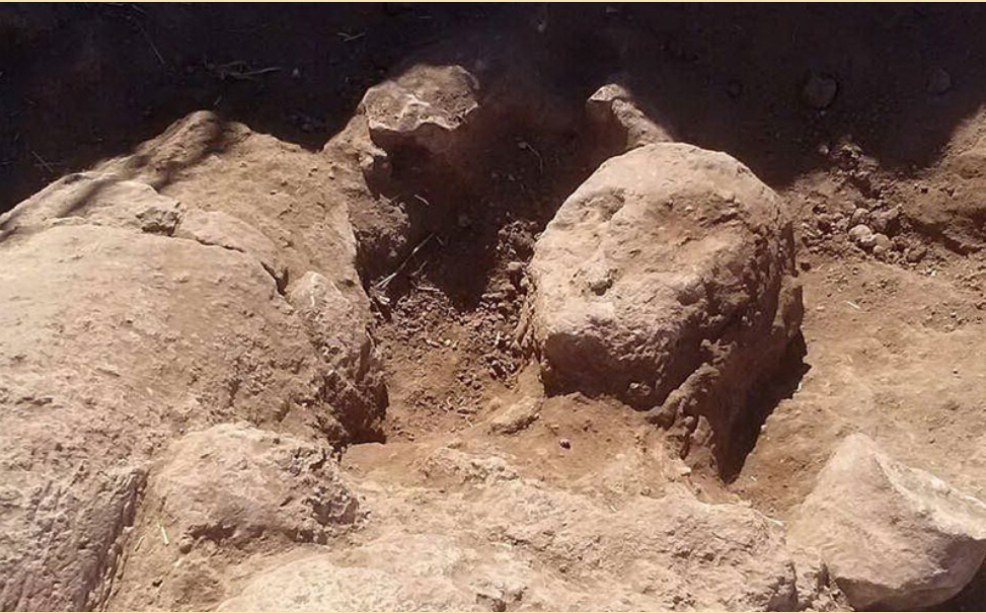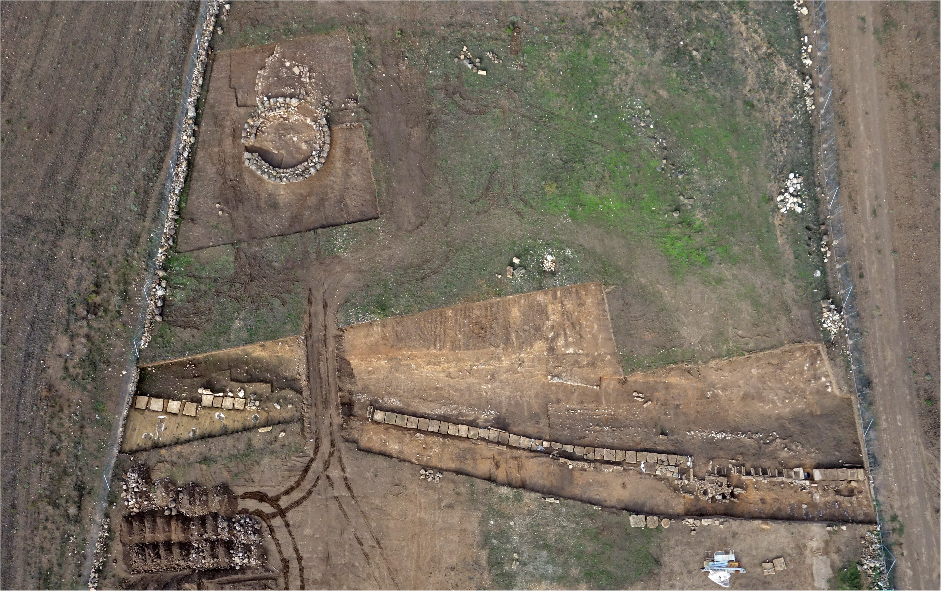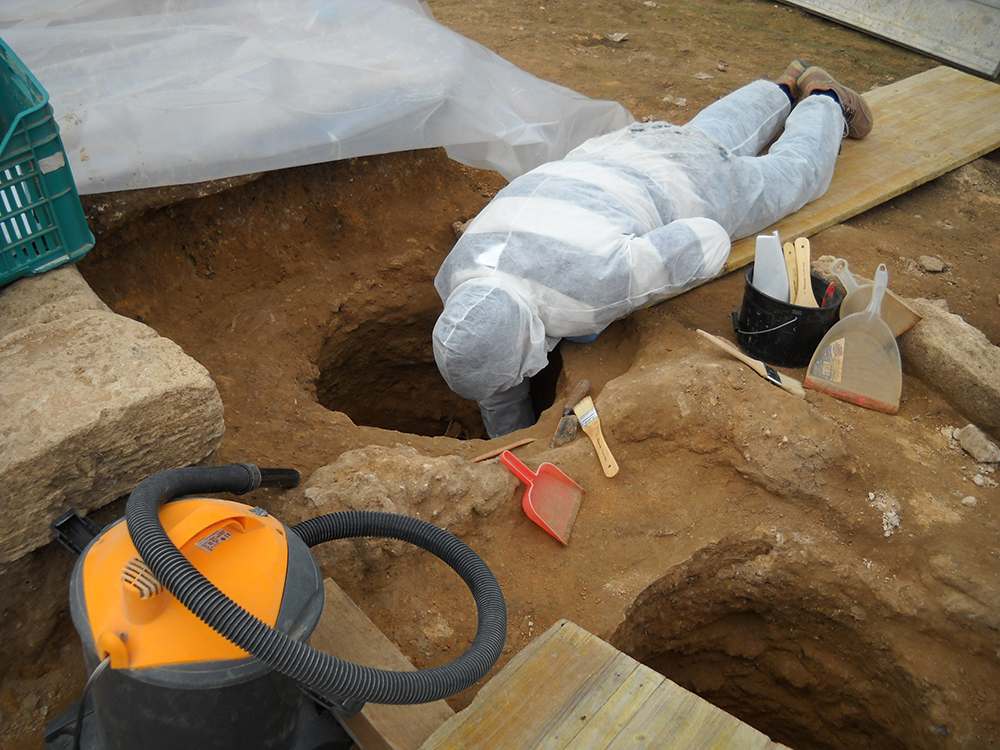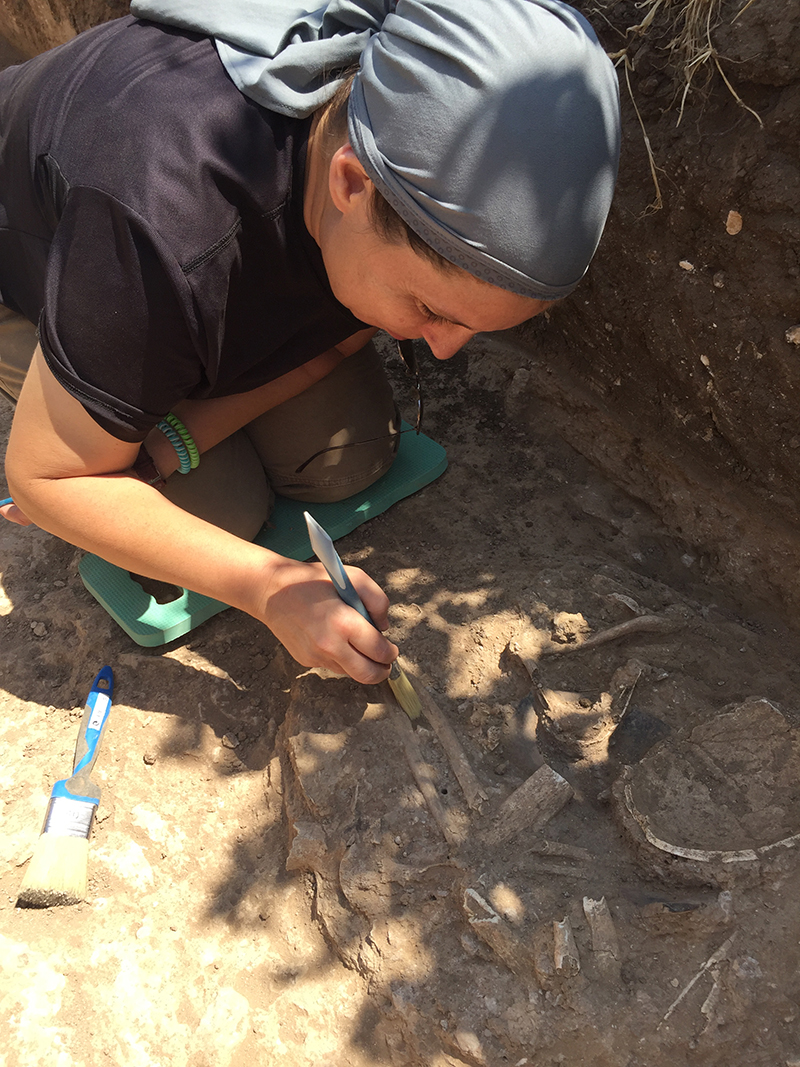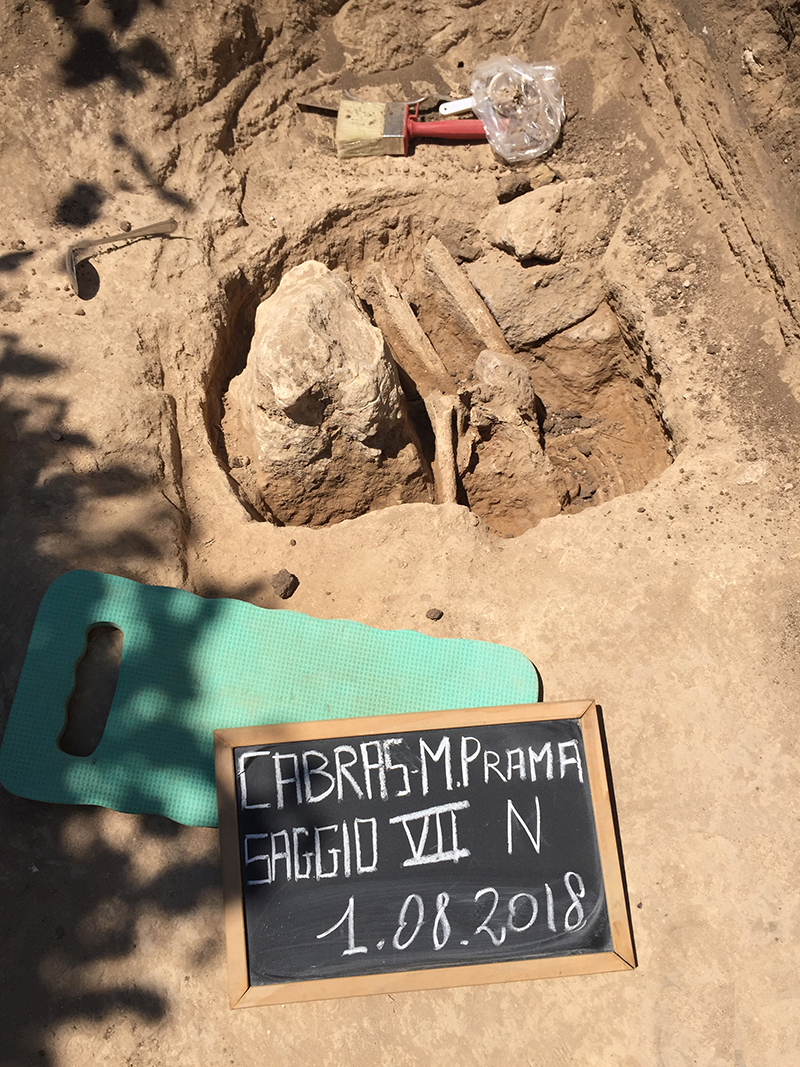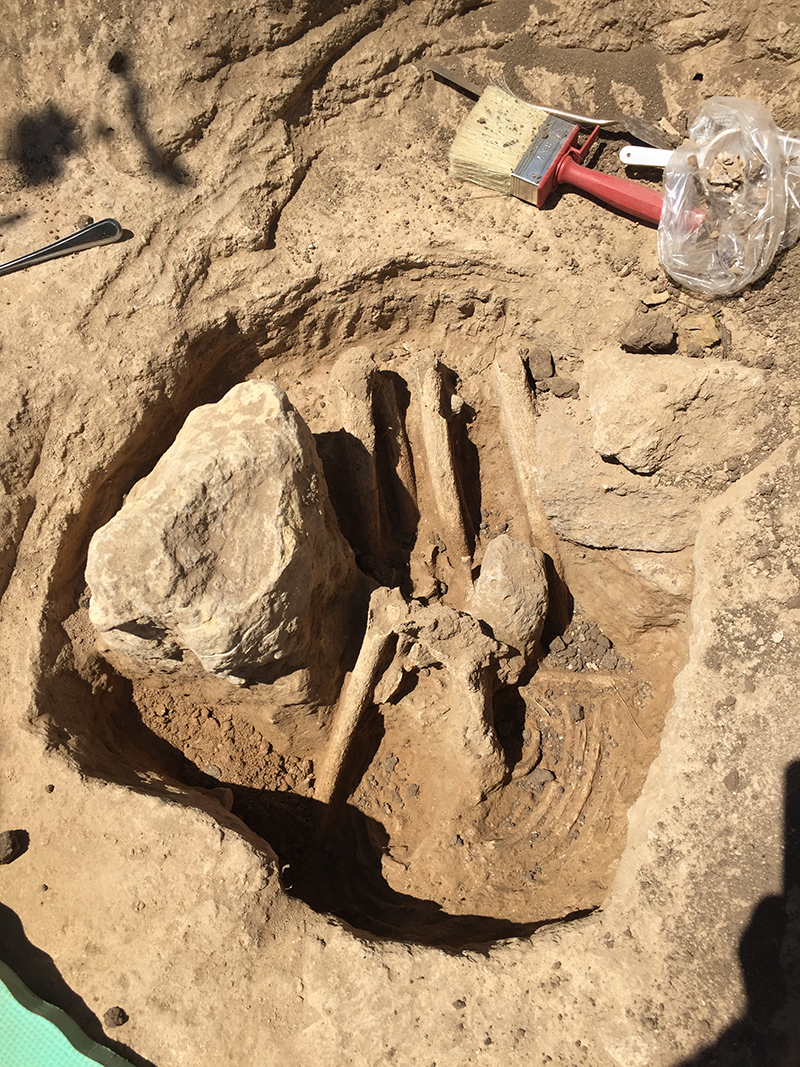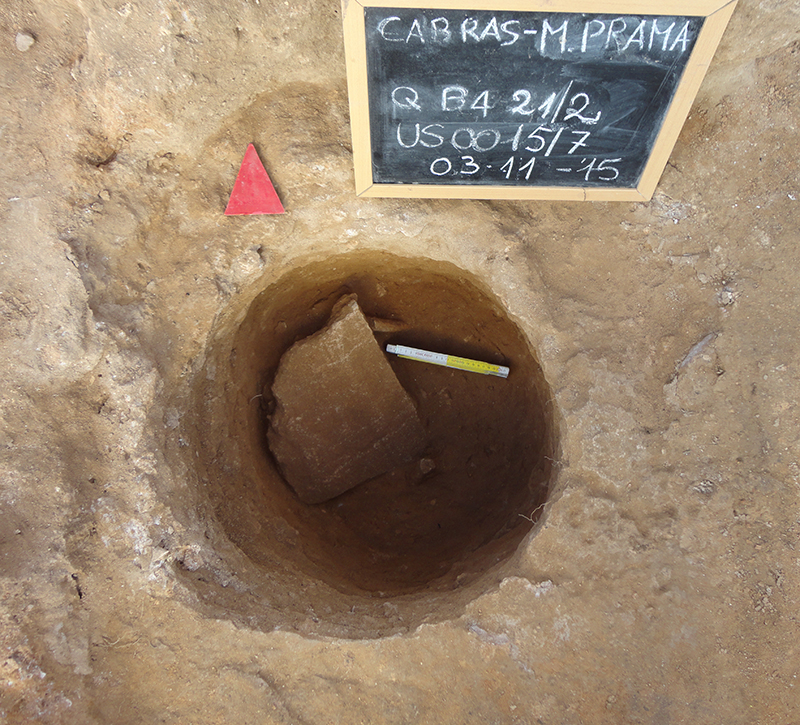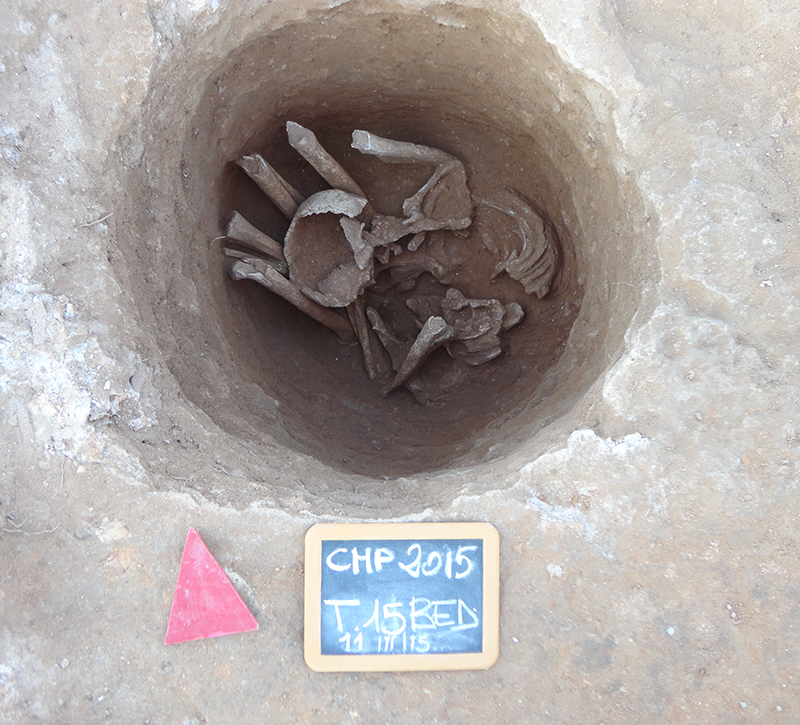Who were the Giants
A necropolis or monumental cemetery where a kind of funerary ritual was probably practised, dedicated to celebrating the lives of young men who lay in their individual tombs, architecturally arranged along a long straight path adorned with monumental statues of warriors, archers and boxers: this is Mont’e Prama.
But who were the people worthy of such celebration? Biological anthropology has tried to tell us something about them.
The excavations
Archaeological excavations have revealed numerous tombs and just as many bodies.
Since the 1970s around 125 tombs belonging to the Mont’e Prama burial types have been identified and recognised (see the section “Discovery and excavations“). Of these, just over 60 tombs have been excavated. Some of these have been studied extensively, while others are still being studied.
In the 1970s, 41 of the 62 tombs identified were excavated. The excavations yielded the same number of buried bodies, which were studied by Ornella Fonzo and Elsa Pacciani (from the Archaeological Superintendency of Tuscany), specialists in biological anthropology, and analysed at the Archaeoanthropology Laboratory of the Superintendency.
When excavations were resumed in 2014, between 24 September and 30 November of that year, 16 tombs were identified and excavated, 8 of which with a slab and 8 of the simple shaft type. The excavation and recovery of the buried bodies was planned and carried out so as to take bone and sediment samples for testing of the ancient DNA.
In 2015, 28 tombs were identified. The systematic excavation was carried out on 6 tombs located in the “Bedini sector”, comprising 3 graves covered by a slab and 3 simple or structured shaft graves. The human remains were excavated and recovered by biological anthropologist Ornella Fonzo and the data analysed at the Archaeo-anthropology laboratory of the Archaeology, Arts and Landscape Superintendency of Cagliari, Oristano and South Sardinia.
How were the buried bodies of Mont’e Prama recovered?
During the 2014-2015 excavations, all activities were personally performed and monitored by anthropologists working at the site, who identified the items as they were unearthed, described their locations, and handled the initial conservation of each of the finds.
The anthropologists carrying out the excavation wore a coverall with a hood, mask and gloves, to preserve the bone remains from contamination for future analysis. At the top layers, the work was carried out with the trowel and broad brush, later moving on to fine instruments such as anatomical scalpels and narrower brushes and, as they got closer to the bones, to boxwood spatulas and thin brushes. The loosened soil was removed with a brush and small dustpan or by means of a low-powered vacuum cleaner. Due to the structure of the tombs, the excavation proved rather difficult, with poor visibility and a lack of air inside.
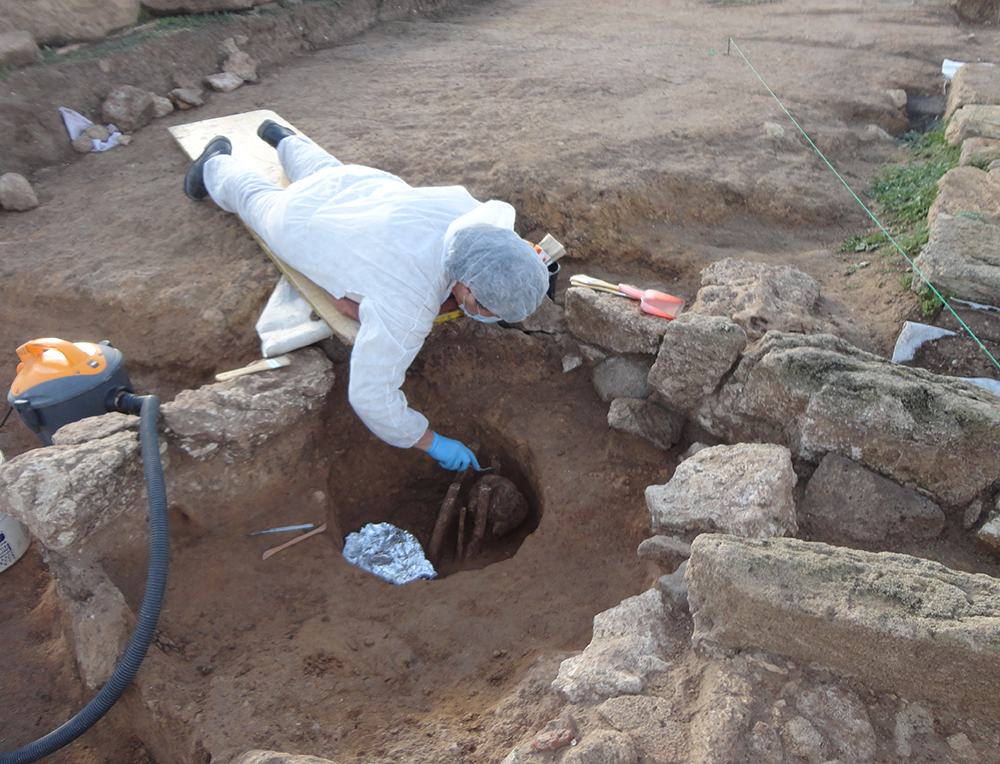

After being recovered from the excavation, the skeletons were dealt with one at a time and kept constantly separated, as the condition of the bone surfaces did not allow labelling of the individual remains. The finds were photographed before the soil was removed. Given their extreme fragility, the bones were subjected to mechanical cleaning with wooden spatulas and brushes. When possible, they were also treated with a soft brush dampened with water. The same treatment was applied to the crowns of the teeth, except for a few, including the roots, which might have disintegrated if moistened.
During cleaning, soil samples were taken to supplement the samples collected during excavation.
Between 2016 and 2018, the Archaeology, Art and Landscape Superintendency of Cagliari, Oristano and southern Sardinia carried out some short sampling investigations, which led to the discovery of numerous tombs, of which only three simple shaft tombs were excavated. The data is still being analysed and studied.
The buried bodies of the Mont’e Prama necropolis
On the basis of the observations made during the excavation, on the position of the bones at the moment of their discovery and their state of preservation, based on the photographic documentation and the study of the skeletal remains in the laboratory, the remains consisted of primary burials, i.e. as originally laid, without subsequent manipulation or reburial.
In the graves with a slab cover, the deceased were laid to rest seated at the bottom of individual pits, generally with their backs facing east, knees bent tightly in front of the chest and ankles often crossed, arms bent at the elbow and hands in front of the chest. The skull would have tilted towards the chest, before becoming detached and falling into the space between the abdomen and the thighs. Consequently, it has not been possible to reconstruct the original orientation of the face because, as the fleshy parts decomposed, the skull fell down. The legs were always sharply bent, with the knees parted, pointing upwards, and the feet close to the pelvis and close together. The arms were also bent, with the elbows more or less distanced from the torso and the hands folded in front.
The bones were in a poor state of preservation, eroded and chipped. This made some of the data difficult to collect. Nevertheless, the anthropological analysis, approximate age at death and sex were determined on the basis of the morphological (form-related) and morphometric (measurement-related) elements that could be detected. The degree of dental wear was also noted and dental cavities were coded.
For some remains, the muscles were analysed and some evidence of disease was found. Finally, bone samples were taken for absolute dating and for isotope analysis aimed at the study of diet, which is still in progress.
Young males
The genetic tests carried out on the teeth indicate a closed community, which probably practised inbreeding, i.e. mating within the same social group. This suggests that the buried bodies of Mont’e Prama belonged to the same clan.
It has been possible to identify the sex and age of most of the specimens found. Male individuals clearly outnumber female individuals.
On the basis of the analyses carried out on the 41 individuals found during the excavations of the 1970s, 27 were male, 1 female, 4 probably female and 9 undetermined. DNA studies carried out on the remains unearthed in 2014, some partially published and some still ongoing, found that 9 of the individuals were male. Lastly, analyses of the 6 bodies unearthed in 2015 have revealed that they were all male.
With regard to the age of the individuals, the analyses show the absence of infants and the elderly, the presence of about ten individuals aged between 15 and 18 years and the prevalence of “young adults” (21-42 years). The age at death of the interred individuals is a salient and characteristic feature of the deceased of Mont’e Prama. It is a particularly important aspect for understanding the connotation of the group with respect to the population to which it belongs.
The absence of infants and the elderly, the presence of many adolescents or very young adults and the predominance of young adults has led scholars to think that this was a selective burial ground, first of all on the basis of sex and then on the basis of a criterion of role and social function.


Athletes, warriors, heroes
The males present distinctive elements of strength with well-marked muscle attachments that seem to indicate a group devoted to intense and repeated physical activity, involving both the upper and lower limbs: for example, 80% (an unusually high frequency) of the male samples (Bedini-Tronchetti excavations) show elements in the femurs that indicate stress from work and effort, such as bending and twisting of the thighs. Were they perhaps athletes or elite warriors?
Detailed individual analysis allows us to trace the specific movements carried out with frequency and under stress: in some individuals it was indeed possible to deduce the recurrent use of the right arm associated with the use of the shoulder, arm and forearm and a powerful grip of the hand. Were these sword-wielding warriors?
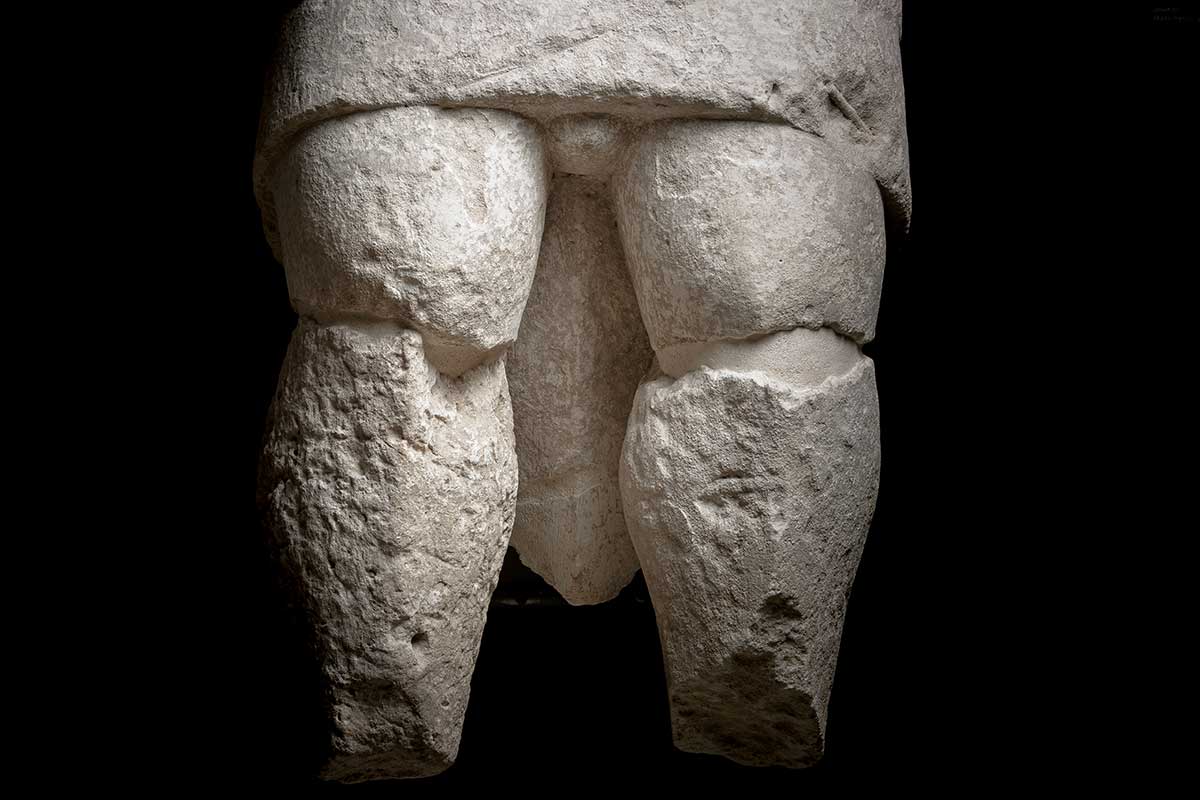
What they ate
As part of a paleo-nutritional and paleo-climatic study of Sardinia, the necropolis of Mont’e Prama provided an outstanding sample, both because of its closed context and because it is the first substantial human group from the Iron Age investigated in Sardinia so far.
The reconstruction of the ancient diet is based on a measurement that scholars call the Carbon and Nitrogen Stable Isotopes in Collagen, which mostly reflects the composition of foods consumed during an individual’s lifetime. This analysis therefore provided insights into the origin of protein in the average diet of a sample of the group, in the years preceding death. Particular attention was paid to the possible consumption of foods of marine origin and to any changes in diet over time or within the group.
The test results reveal an increase in the proportion of animal proteins from the most ancient to the most recent phases and, within the recent phases, an increasing intake of proteins from seafood.
It can be assumed that the human group of Mont’e Prama, as a whole, also used diet as a marker of their status. Lastly, by comparing these data with others found in less “distinguished” burials in Sardinia and interpreting them with caution, it is possible to identify the bodies of Mont’e Prama as a privileged and elite group in progressive identity formation.
When they lived
As part of the paleo-nutritional and paleo-climatic study of Sardinia, the absolute dating of a sample of the group was recorded using the radiocarbon dating technique with accelerator mass spectrometry.
At this stage of the studies, 15 datings are available on 13 tombs and 3 datings on animal bones found in two layers of compartment B, carried out by the laboratories of Heidelberg, Groningen, Caserta and Miami. The type 1 pits of the Bedini and Tronchetti necropolis, the type 2 and intermediate type pits of the Bedini necropolis, the slab-covered tombs of the Bedini necropolis, the slab-covered tombs of the Tronchetti necropolis, the pits of the 2014 necropolis similar to type 1, the slab-covered tombs of the 2014 necropolis and building B were analysed.
The overall picture that emerges from the radiocarbon dating is not yet sufficient and not completely consistent, and is therefore not yet reliable for statistical evaluations. Some tombs found in the same stratigraphic context have revealed very different datings and in some cases the radiocarbon dating is significantly different from the archaeological dating proposed on the basis of the studies of the ceramic vessels found beneath the deceased. In general, the earliest datings carried out in the Groningen and Caserta laboratories seem older than those made later in two different laboratories in Miami.
Despite these still unresolved uncertainties, scholars still accept the hypothesis that proposes the following phases of development of the necropolis of Mont’e Prama: first the simple pits (type 1) of the Bedini and Tronchetti necropolis, then the structured pits (type 2) of the Bedini necropolis, with different phases and different arrangements and, lastly, the long row of slab-covered tombs of the Bedini, Tronchetti and 2014 necropolises, in possible succession from north to south.





